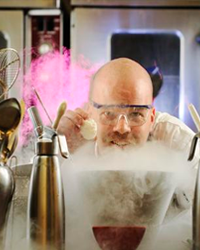 Earlier this year, executives at Crown Melbourne secured another top chef to open a restaurant in their facility. Heston Blumenthal joins the likes of Neil Perry, Guillaume Brahimi and Nobu Matsuhisa in lending his famous name and award winning food to an eatery at the famous Southbank property.
Earlier this year, executives at Crown Melbourne secured another top chef to open a restaurant in their facility. Heston Blumenthal joins the likes of Neil Perry, Guillaume Brahimi and Nobu Matsuhisa in lending his famous name and award winning food to an eatery at the famous Southbank property.
Ok, so most publicans and club managers are not billionaires with access to the sort of financial capital that Crown is able to utilise developing exciting and exotic food businesses. Nor are they likely to be mates with celebrity chefs like James Packer is – but surely there is still scope to introduce some cutting edge cuisine to menus in suburban venues to build and maintain a reputation for great food?
Simple initiatives such as themed menus or themed events are a good starting point for experimenting with different food styles. The Daily Telegraph in Sydney reported last month that a club in that city had introduced a food truck similar to those made famous in San Francisco. Another consideration for venues with unused square meters might be to cash in on the ‘pop-up’ craze and surprise and delight your patrons with a novel and exciting food offer. There is plenty of inspiration out there regarding new food trends as we continue to see innovative new concepts like gyoza bars, nitrogen chilled ice-cream, a Mexican joint in every precinct, and Asian, Middle Eastern or Mediterranean share plates as far as they eye can see. However, despite the growing popularity in experiential dining, many venues appear to be reluctant to deviate from buffets, brasseries, bistros, steakhouses and cafés… or some combination thereof.
Aletia Ramscar, one of CTA’s most experienced chef trainers, tells me that one of the latest and greatest gastronomic cookery methods ‘sous vide‘ has potential to put a pub or club on the map if they’re prepared to be a bit experimental. Sous vide’s literal translation is ‘under vacuum’. It’s a low temperature cooking method that improves consistency, allows for greater flavour intensity and assists chefs to maximise yield.
“The food is vacuum sealed in a bag with spices so it retains more flavour, nutrients and texture, and allows chefs to refrigerate or freeze the food straight from the water bath, without actually having to handle the food.”
“This method not only enables accuracy but also food to be pre-portioned and creates no waste whatsoever,” Aletia tells me.
TV ratings for shows like Master Chef and My Kitchen Rules would suggest that our pub and club diners are interested in food and want food to be interesting. This would suggest that developing a ‘food strategy’ would be highly beneficial for venues seeking to gain market share by surprising and delighting their customers with a unique menu.
Rather than simply assuming that diners in our establishments will continue to be satisfied with steaks and schnitzels ever more, let’s find out about our patrons’ preferences through research such as focus groups and surveys. Let’s embark upon fact finding missions in food precincts to see what’s out there. And let’s develop a catering plan for our venues that makes provision for capital investment required, budgets generously for marketing and PR to create hype around our new food offerings, and for ensuring that food serves to attract new and existing patrons to our venues to purchase drinks in our bars and play our gaming machines.
To find out how DWS can assist you in researching and developing a unique food strategy that will contribute to your earning capabilities, contact us on 07 3878 9355 or info@dws.net.au.



